The Beveridge Report: A Blueprint for the British Welfare State
VerifiedAdded on 2023/03/31
|9
|2018
|209
AI Summary
This essay discusses the Beveridge Report, a government report that laid the foundation for the post-war British welfare state. It examines the key points of the report, the significance of the report, and the five giants identified by William Beveridge. The essay also explores the impact of the report on the education system and the progress made in addressing the giants.
Contribute Materials
Your contribution can guide someone’s learning journey. Share your
documents today.
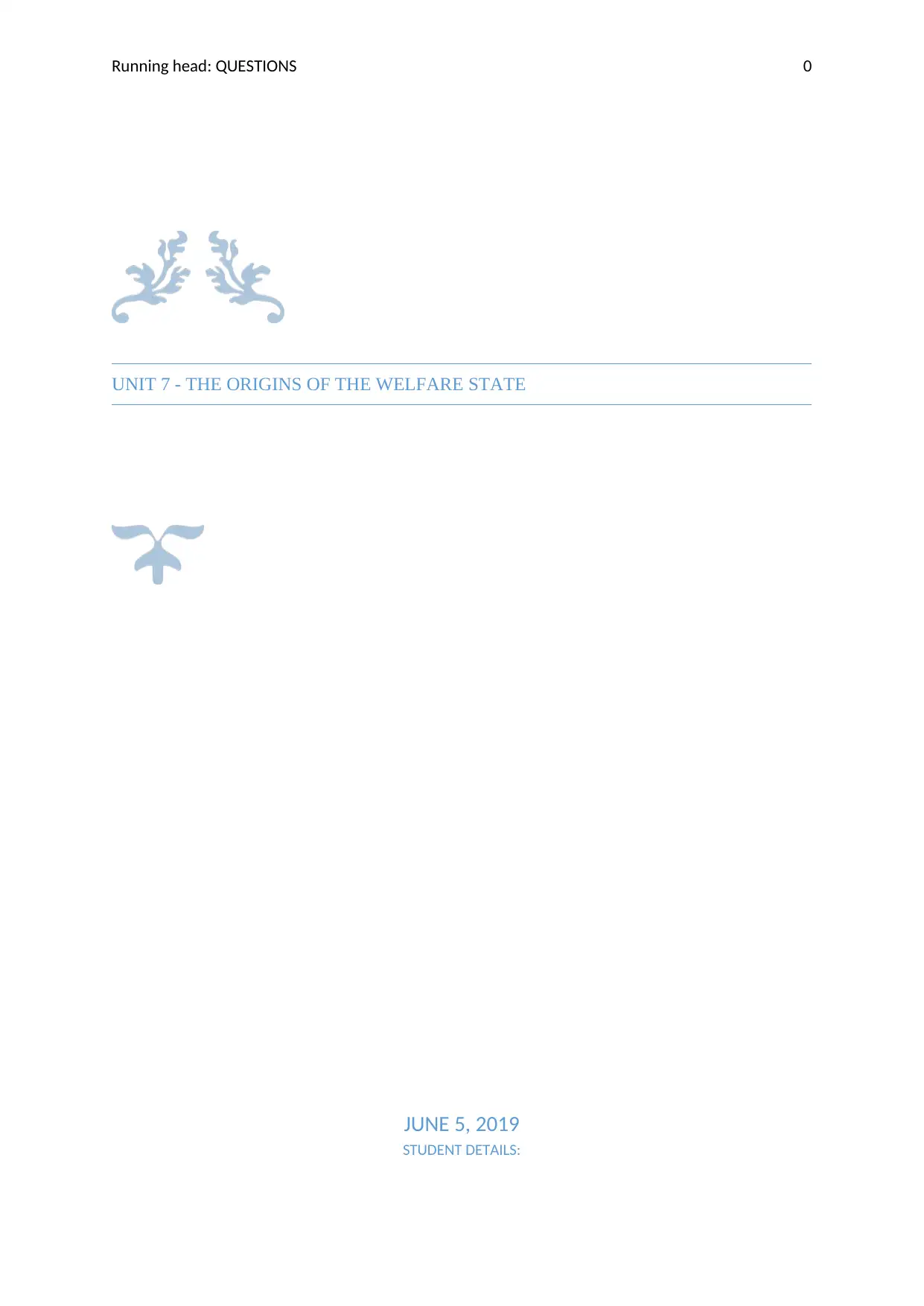
Running head: QUESTIONS 0
UNIT 7 - THE ORIGINS OF THE WELFARE STATE
JUNE 5, 2019
STUDENT DETAILS:
UNIT 7 - THE ORIGINS OF THE WELFARE STATE
JUNE 5, 2019
STUDENT DETAILS:
Secure Best Marks with AI Grader
Need help grading? Try our AI Grader for instant feedback on your assignments.
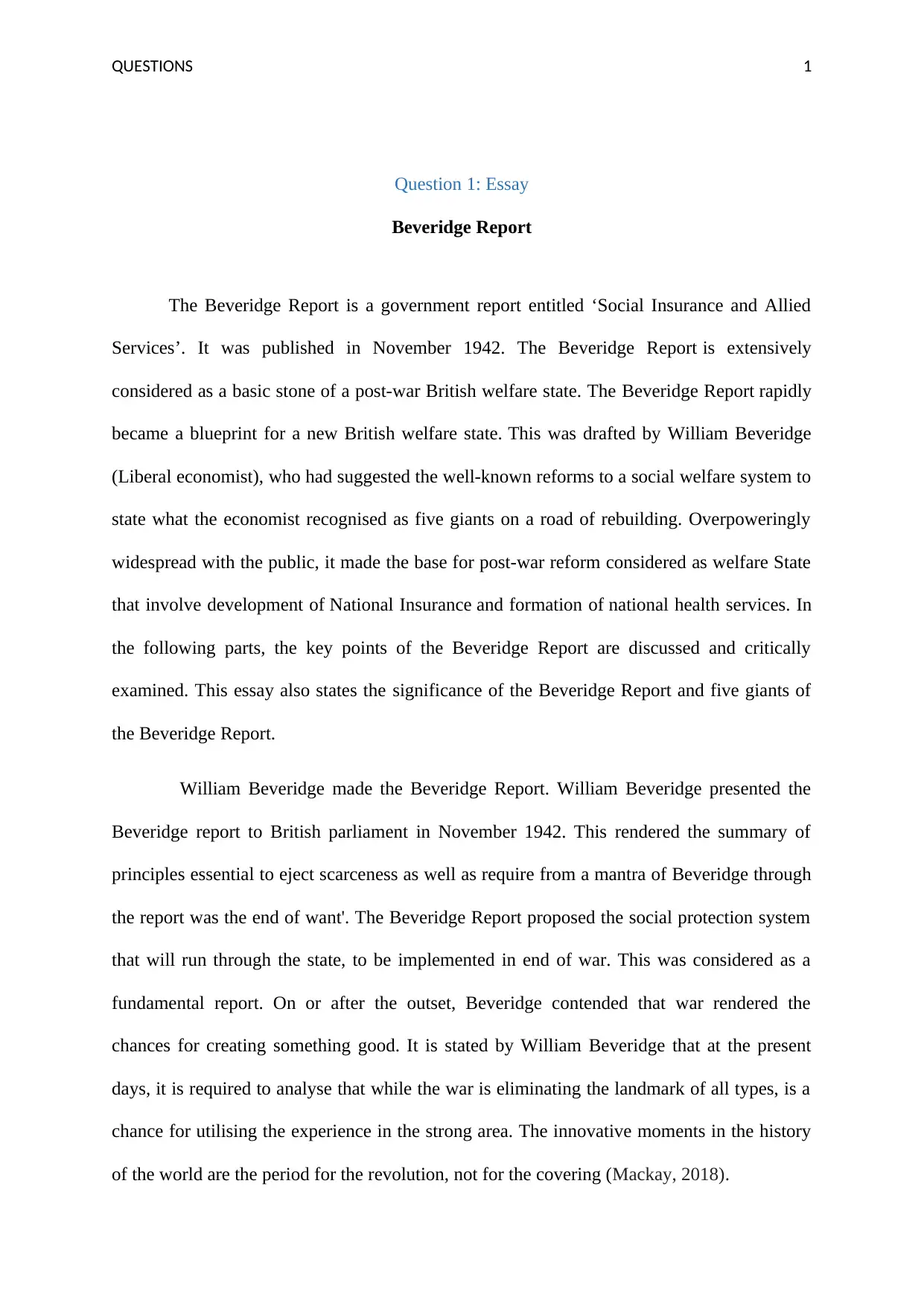
QUESTIONS 1
Question 1: Essay
Beveridge Report
The Beveridge Report is a government report entitled ‘Social Insurance and Allied
Services’. It was published in November 1942. The Beveridge Report is extensively
considered as a basic stone of a post-war British welfare state. The Beveridge Report rapidly
became a blueprint for a new British welfare state. This was drafted by William Beveridge
(Liberal economist), who had suggested the well-known reforms to a social welfare system to
state what the economist recognised as five giants on a road of rebuilding. Overpoweringly
widespread with the public, it made the base for post-war reform considered as welfare State
that involve development of National Insurance and formation of national health services. In
the following parts, the key points of the Beveridge Report are discussed and critically
examined. This essay also states the significance of the Beveridge Report and five giants of
the Beveridge Report.
William Beveridge made the Beveridge Report. William Beveridge presented the
Beveridge report to British parliament in November 1942. This rendered the summary of
principles essential to eject scarceness as well as require from a mantra of Beveridge through
the report was the end of want'. The Beveridge Report proposed the social protection system
that will run through the state, to be implemented in end of war. This was considered as a
fundamental report. On or after the outset, Beveridge contended that war rendered the
chances for creating something good. It is stated by William Beveridge that at the present
days, it is required to analyse that while the war is eliminating the landmark of all types, is a
chance for utilising the experience in the strong area. The innovative moments in the history
of the world are the period for the revolution, not for the covering (Mackay, 2018).
Question 1: Essay
Beveridge Report
The Beveridge Report is a government report entitled ‘Social Insurance and Allied
Services’. It was published in November 1942. The Beveridge Report is extensively
considered as a basic stone of a post-war British welfare state. The Beveridge Report rapidly
became a blueprint for a new British welfare state. This was drafted by William Beveridge
(Liberal economist), who had suggested the well-known reforms to a social welfare system to
state what the economist recognised as five giants on a road of rebuilding. Overpoweringly
widespread with the public, it made the base for post-war reform considered as welfare State
that involve development of National Insurance and formation of national health services. In
the following parts, the key points of the Beveridge Report are discussed and critically
examined. This essay also states the significance of the Beveridge Report and five giants of
the Beveridge Report.
William Beveridge made the Beveridge Report. William Beveridge presented the
Beveridge report to British parliament in November 1942. This rendered the summary of
principles essential to eject scarceness as well as require from a mantra of Beveridge through
the report was the end of want'. The Beveridge Report proposed the social protection system
that will run through the state, to be implemented in end of war. This was considered as a
fundamental report. On or after the outset, Beveridge contended that war rendered the
chances for creating something good. It is stated by William Beveridge that at the present
days, it is required to analyse that while the war is eliminating the landmark of all types, is a
chance for utilising the experience in the strong area. The innovative moments in the history
of the world are the period for the revolution, not for the covering (Mackay, 2018).
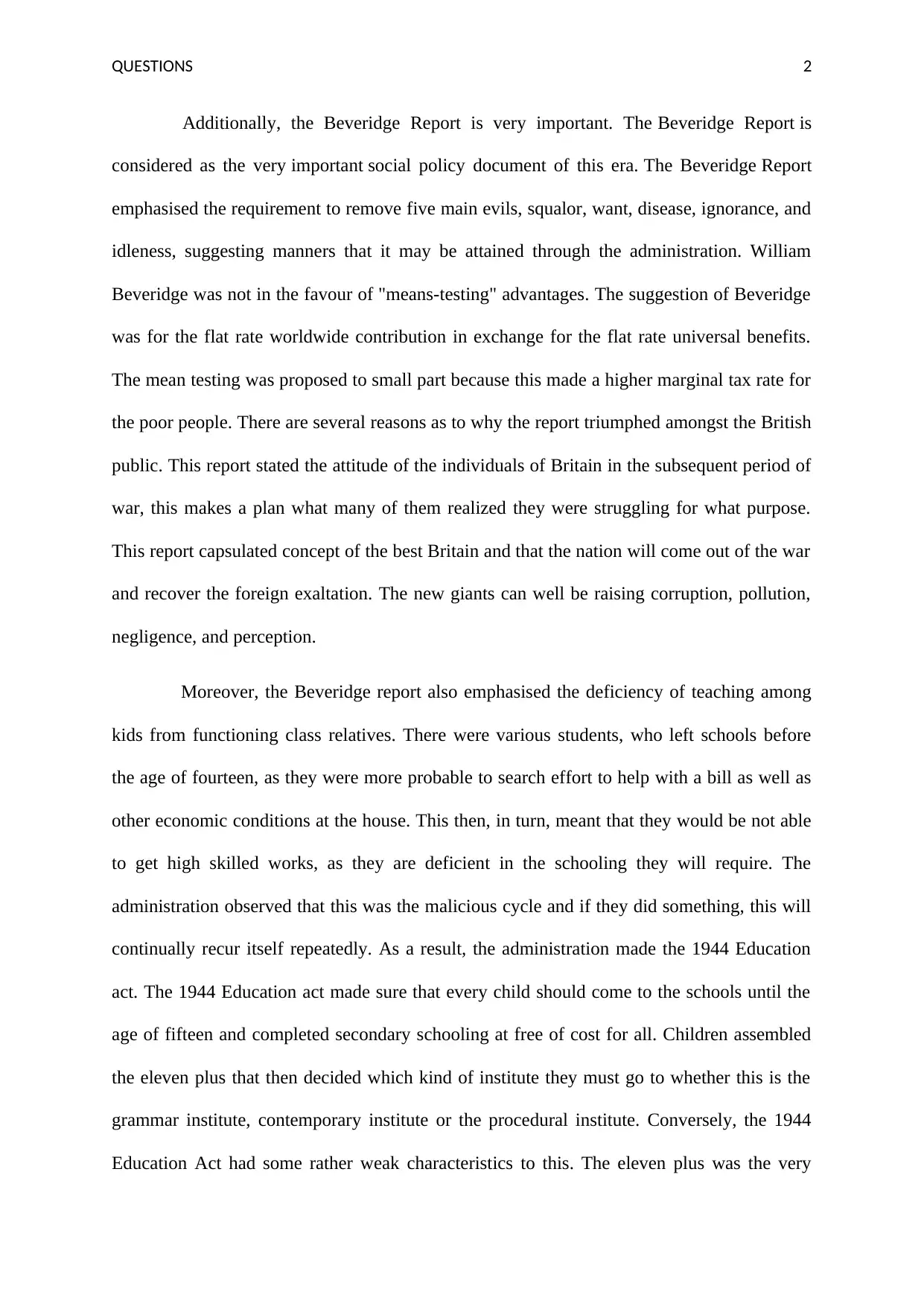
QUESTIONS 2
Additionally, the Beveridge Report is very important. The Beveridge Report is
considered as the very important social policy document of this era. The Beveridge Report
emphasised the requirement to remove five main evils, squalor, want, disease, ignorance, and
idleness, suggesting manners that it may be attained through the administration. William
Beveridge was not in the favour of "means-testing" advantages. The suggestion of Beveridge
was for the flat rate worldwide contribution in exchange for the flat rate universal benefits.
The mean testing was proposed to small part because this made a higher marginal tax rate for
the poor people. There are several reasons as to why the report triumphed amongst the British
public. This report stated the attitude of the individuals of Britain in the subsequent period of
war, this makes a plan what many of them realized they were struggling for what purpose.
This report capsulated concept of the best Britain and that the nation will come out of the war
and recover the foreign exaltation. The new giants can well be raising corruption, pollution,
negligence, and perception.
Moreover, the Beveridge report also emphasised the deficiency of teaching among
kids from functioning class relatives. There were various students, who left schools before
the age of fourteen, as they were more probable to search effort to help with a bill as well as
other economic conditions at the house. This then, in turn, meant that they would be not able
to get high skilled works, as they are deficient in the schooling they will require. The
administration observed that this was the malicious cycle and if they did something, this will
continually recur itself repeatedly. As a result, the administration made the 1944 Education
act. The 1944 Education act made sure that every child should come to the schools until the
age of fifteen and completed secondary schooling at free of cost for all. Children assembled
the eleven plus that then decided which kind of institute they must go to whether this is the
grammar institute, contemporary institute or the procedural institute. Conversely, the 1944
Education Act had some rather weak characteristics to this. The eleven plus was the very
Additionally, the Beveridge Report is very important. The Beveridge Report is
considered as the very important social policy document of this era. The Beveridge Report
emphasised the requirement to remove five main evils, squalor, want, disease, ignorance, and
idleness, suggesting manners that it may be attained through the administration. William
Beveridge was not in the favour of "means-testing" advantages. The suggestion of Beveridge
was for the flat rate worldwide contribution in exchange for the flat rate universal benefits.
The mean testing was proposed to small part because this made a higher marginal tax rate for
the poor people. There are several reasons as to why the report triumphed amongst the British
public. This report stated the attitude of the individuals of Britain in the subsequent period of
war, this makes a plan what many of them realized they were struggling for what purpose.
This report capsulated concept of the best Britain and that the nation will come out of the war
and recover the foreign exaltation. The new giants can well be raising corruption, pollution,
negligence, and perception.
Moreover, the Beveridge report also emphasised the deficiency of teaching among
kids from functioning class relatives. There were various students, who left schools before
the age of fourteen, as they were more probable to search effort to help with a bill as well as
other economic conditions at the house. This then, in turn, meant that they would be not able
to get high skilled works, as they are deficient in the schooling they will require. The
administration observed that this was the malicious cycle and if they did something, this will
continually recur itself repeatedly. As a result, the administration made the 1944 Education
act. The 1944 Education act made sure that every child should come to the schools until the
age of fifteen and completed secondary schooling at free of cost for all. Children assembled
the eleven plus that then decided which kind of institute they must go to whether this is the
grammar institute, contemporary institute or the procedural institute. Conversely, the 1944
Education Act had some rather weak characteristics to this. The eleven plus was the very
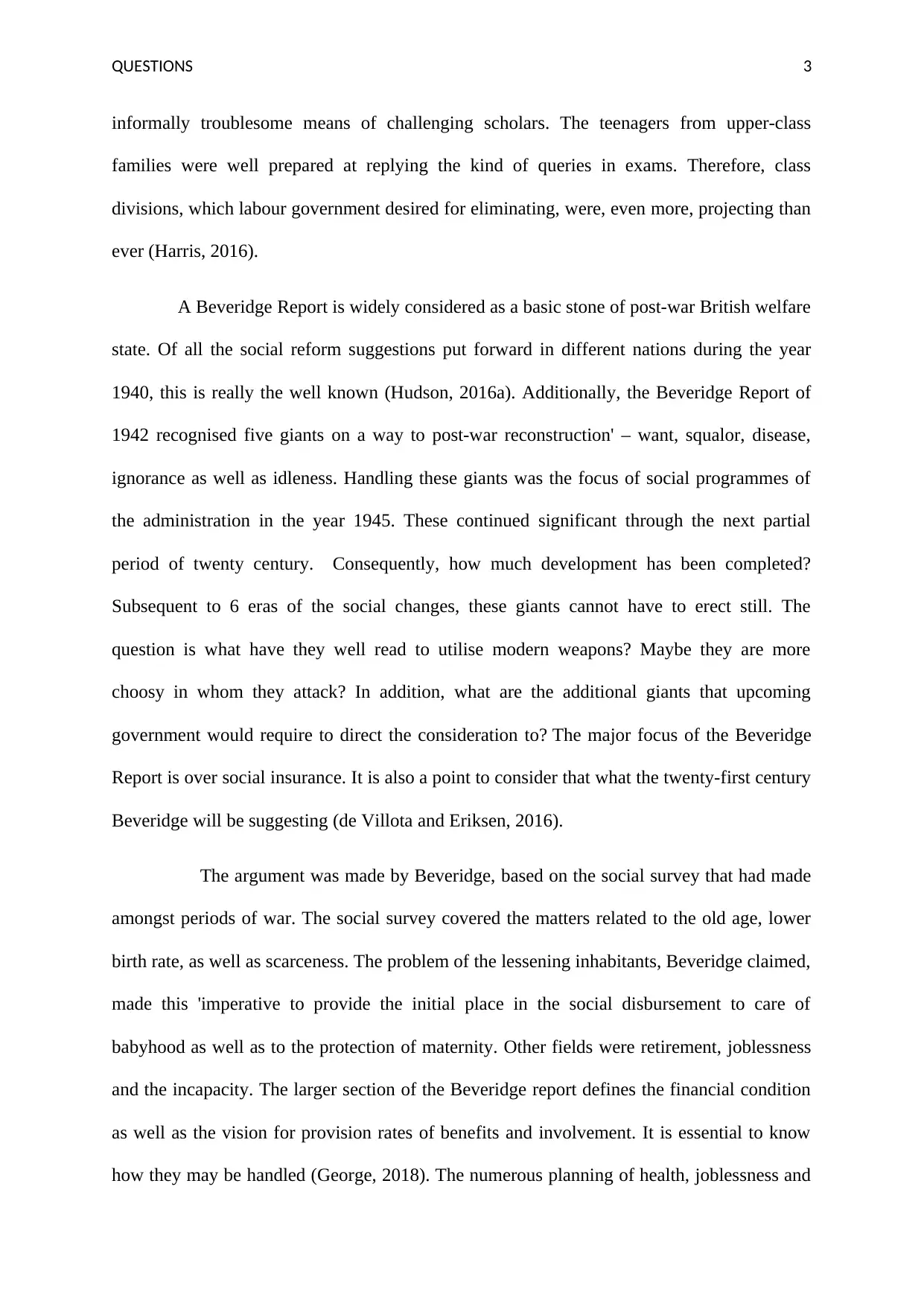
QUESTIONS 3
informally troublesome means of challenging scholars. The teenagers from upper-class
families were well prepared at replying the kind of queries in exams. Therefore, class
divisions, which labour government desired for eliminating, were, even more, projecting than
ever (Harris, 2016).
A Beveridge Report is widely considered as a basic stone of post-war British welfare
state. Of all the social reform suggestions put forward in different nations during the year
1940, this is really the well known (Hudson, 2016a). Additionally, the Beveridge Report of
1942 recognised five giants on a way to post-war reconstruction' – want, squalor, disease,
ignorance as well as idleness. Handling these giants was the focus of social programmes of
the administration in the year 1945. These continued significant through the next partial
period of twenty century. Consequently, how much development has been completed?
Subsequent to 6 eras of the social changes, these giants cannot have to erect still. The
question is what have they well read to utilise modern weapons? Maybe they are more
choosy in whom they attack? In addition, what are the additional giants that upcoming
government would require to direct the consideration to? The major focus of the Beveridge
Report is over social insurance. It is also a point to consider that what the twenty-first century
Beveridge will be suggesting (de Villota and Eriksen, 2016).
The argument was made by Beveridge, based on the social survey that had made
amongst periods of war. The social survey covered the matters related to the old age, lower
birth rate, as well as scarceness. The problem of the lessening inhabitants, Beveridge claimed,
made this 'imperative to provide the initial place in the social disbursement to care of
babyhood as well as to the protection of maternity. Other fields were retirement, joblessness
and the incapacity. The larger section of the Beveridge report defines the financial condition
as well as the vision for provision rates of benefits and involvement. It is essential to know
how they may be handled (George, 2018). The numerous planning of health, joblessness and
informally troublesome means of challenging scholars. The teenagers from upper-class
families were well prepared at replying the kind of queries in exams. Therefore, class
divisions, which labour government desired for eliminating, were, even more, projecting than
ever (Harris, 2016).
A Beveridge Report is widely considered as a basic stone of post-war British welfare
state. Of all the social reform suggestions put forward in different nations during the year
1940, this is really the well known (Hudson, 2016a). Additionally, the Beveridge Report of
1942 recognised five giants on a way to post-war reconstruction' – want, squalor, disease,
ignorance as well as idleness. Handling these giants was the focus of social programmes of
the administration in the year 1945. These continued significant through the next partial
period of twenty century. Consequently, how much development has been completed?
Subsequent to 6 eras of the social changes, these giants cannot have to erect still. The
question is what have they well read to utilise modern weapons? Maybe they are more
choosy in whom they attack? In addition, what are the additional giants that upcoming
government would require to direct the consideration to? The major focus of the Beveridge
Report is over social insurance. It is also a point to consider that what the twenty-first century
Beveridge will be suggesting (de Villota and Eriksen, 2016).
The argument was made by Beveridge, based on the social survey that had made
amongst periods of war. The social survey covered the matters related to the old age, lower
birth rate, as well as scarceness. The problem of the lessening inhabitants, Beveridge claimed,
made this 'imperative to provide the initial place in the social disbursement to care of
babyhood as well as to the protection of maternity. Other fields were retirement, joblessness
and the incapacity. The larger section of the Beveridge report defines the financial condition
as well as the vision for provision rates of benefits and involvement. It is essential to know
how they may be handled (George, 2018). The numerous planning of health, joblessness and
Secure Best Marks with AI Grader
Need help grading? Try our AI Grader for instant feedback on your assignments.
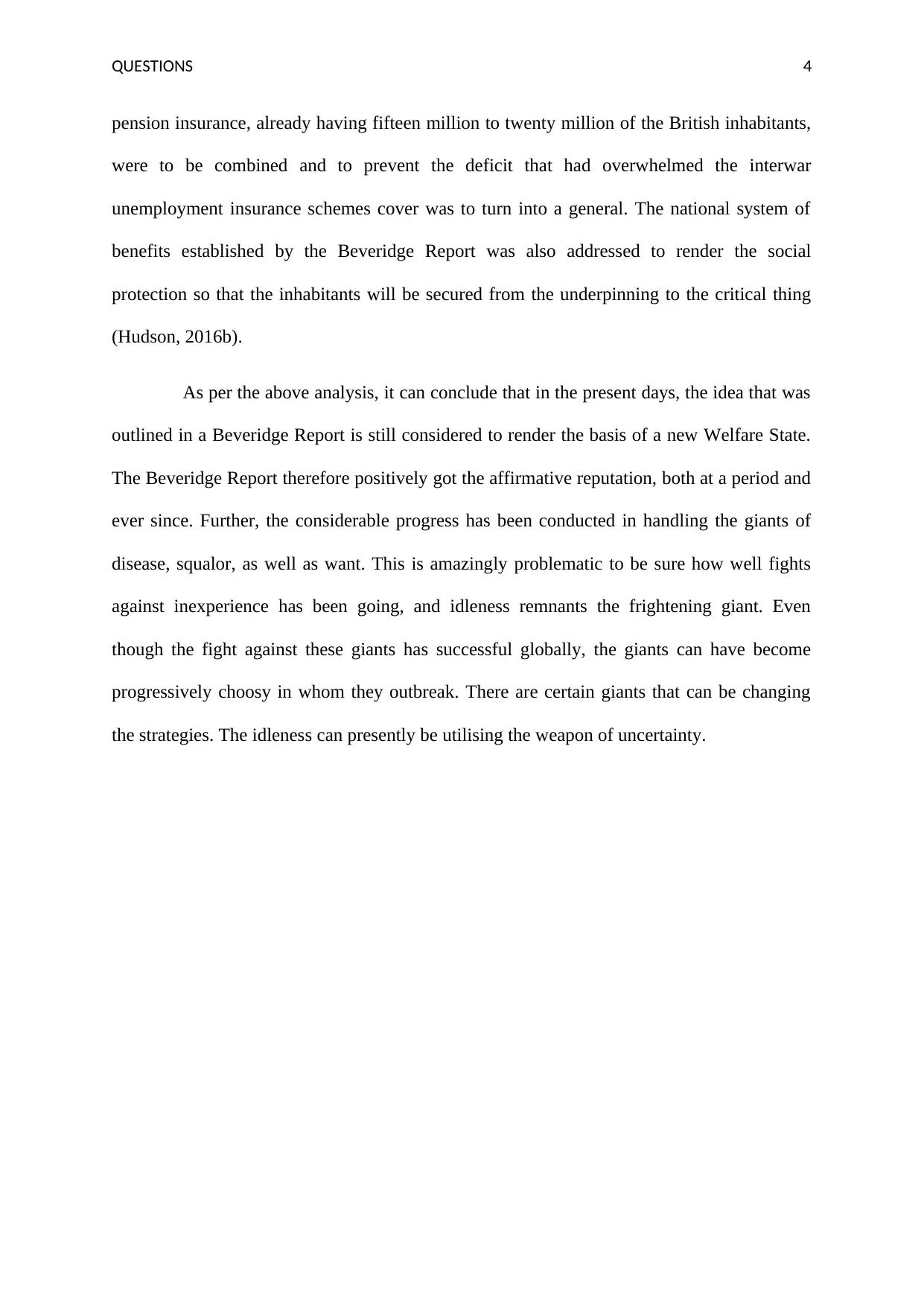
QUESTIONS 4
pension insurance, already having fifteen million to twenty million of the British inhabitants,
were to be combined and to prevent the deficit that had overwhelmed the interwar
unemployment insurance schemes cover was to turn into a general. The national system of
benefits established by the Beveridge Report was also addressed to render the social
protection so that the inhabitants will be secured from the underpinning to the critical thing
(Hudson, 2016b).
As per the above analysis, it can conclude that in the present days, the idea that was
outlined in a Beveridge Report is still considered to render the basis of a new Welfare State.
The Beveridge Report therefore positively got the affirmative reputation, both at a period and
ever since. Further, the considerable progress has been conducted in handling the giants of
disease, squalor, as well as want. This is amazingly problematic to be sure how well fights
against inexperience has been going, and idleness remnants the frightening giant. Even
though the fight against these giants has successful globally, the giants can have become
progressively choosy in whom they outbreak. There are certain giants that can be changing
the strategies. The idleness can presently be utilising the weapon of uncertainty.
pension insurance, already having fifteen million to twenty million of the British inhabitants,
were to be combined and to prevent the deficit that had overwhelmed the interwar
unemployment insurance schemes cover was to turn into a general. The national system of
benefits established by the Beveridge Report was also addressed to render the social
protection so that the inhabitants will be secured from the underpinning to the critical thing
(Hudson, 2016b).
As per the above analysis, it can conclude that in the present days, the idea that was
outlined in a Beveridge Report is still considered to render the basis of a new Welfare State.
The Beveridge Report therefore positively got the affirmative reputation, both at a period and
ever since. Further, the considerable progress has been conducted in handling the giants of
disease, squalor, as well as want. This is amazingly problematic to be sure how well fights
against inexperience has been going, and idleness remnants the frightening giant. Even
though the fight against these giants has successful globally, the giants can have become
progressively choosy in whom they outbreak. There are certain giants that can be changing
the strategies. The idleness can presently be utilising the weapon of uncertainty.
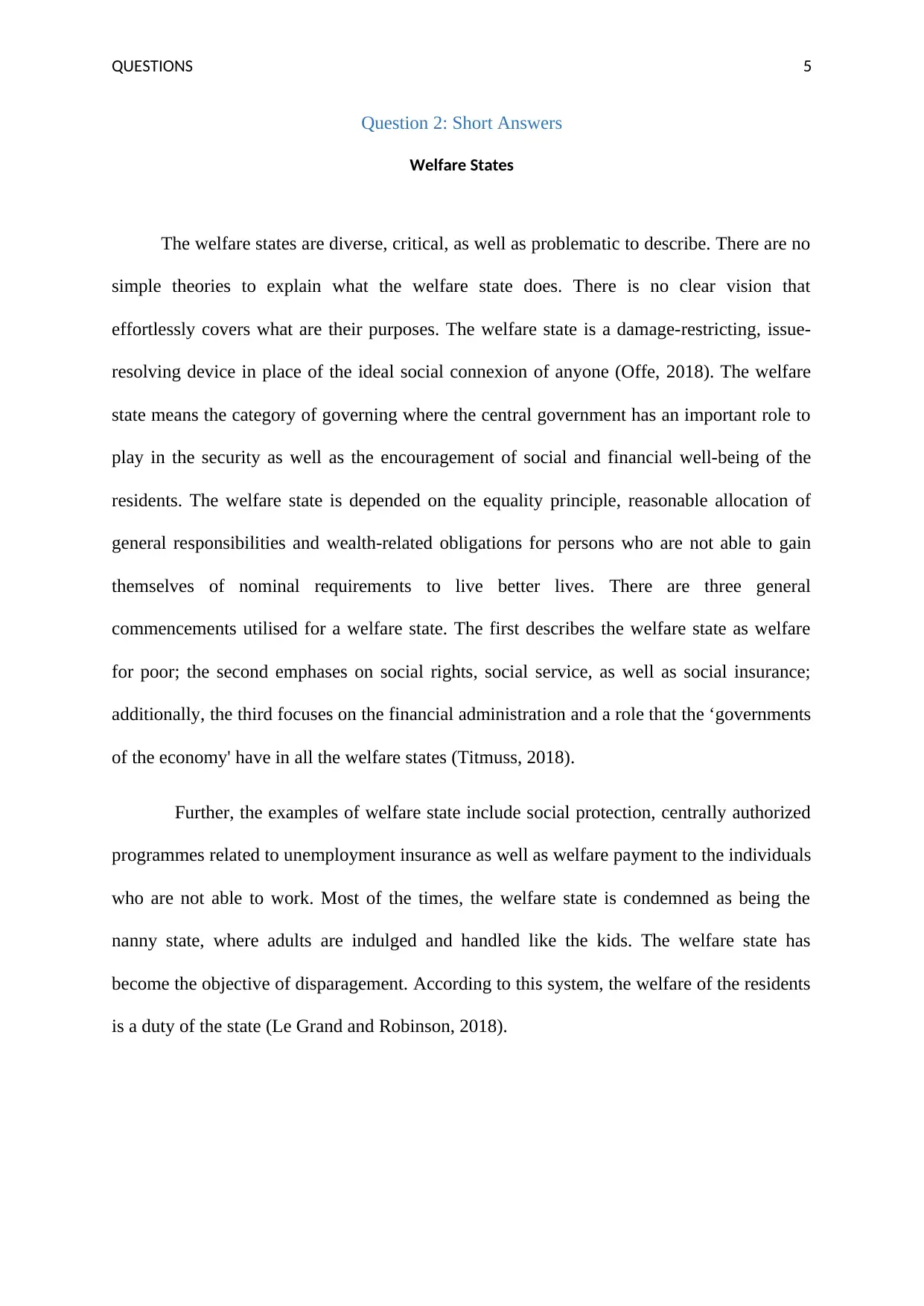
QUESTIONS 5
Question 2: Short Answers
Welfare States
The welfare states are diverse, critical, as well as problematic to describe. There are no
simple theories to explain what the welfare state does. There is no clear vision that
effortlessly covers what are their purposes. The welfare state is a damage-restricting, issue-
resolving device in place of the ideal social connexion of anyone (Offe, 2018). The welfare
state means the category of governing where the central government has an important role to
play in the security as well as the encouragement of social and financial well-being of the
residents. The welfare state is depended on the equality principle, reasonable allocation of
general responsibilities and wealth-related obligations for persons who are not able to gain
themselves of nominal requirements to live better lives. There are three general
commencements utilised for a welfare state. The first describes the welfare state as welfare
for poor; the second emphases on social rights, social service, as well as social insurance;
additionally, the third focuses on the financial administration and a role that the ‘governments
of the economy' have in all the welfare states (Titmuss, 2018).
Further, the examples of welfare state include social protection, centrally authorized
programmes related to unemployment insurance as well as welfare payment to the individuals
who are not able to work. Most of the times, the welfare state is condemned as being the
nanny state, where adults are indulged and handled like the kids. The welfare state has
become the objective of disparagement. According to this system, the welfare of the residents
is a duty of the state (Le Grand and Robinson, 2018).
Question 2: Short Answers
Welfare States
The welfare states are diverse, critical, as well as problematic to describe. There are no
simple theories to explain what the welfare state does. There is no clear vision that
effortlessly covers what are their purposes. The welfare state is a damage-restricting, issue-
resolving device in place of the ideal social connexion of anyone (Offe, 2018). The welfare
state means the category of governing where the central government has an important role to
play in the security as well as the encouragement of social and financial well-being of the
residents. The welfare state is depended on the equality principle, reasonable allocation of
general responsibilities and wealth-related obligations for persons who are not able to gain
themselves of nominal requirements to live better lives. There are three general
commencements utilised for a welfare state. The first describes the welfare state as welfare
for poor; the second emphases on social rights, social service, as well as social insurance;
additionally, the third focuses on the financial administration and a role that the ‘governments
of the economy' have in all the welfare states (Titmuss, 2018).
Further, the examples of welfare state include social protection, centrally authorized
programmes related to unemployment insurance as well as welfare payment to the individuals
who are not able to work. Most of the times, the welfare state is condemned as being the
nanny state, where adults are indulged and handled like the kids. The welfare state has
become the objective of disparagement. According to this system, the welfare of the residents
is a duty of the state (Le Grand and Robinson, 2018).
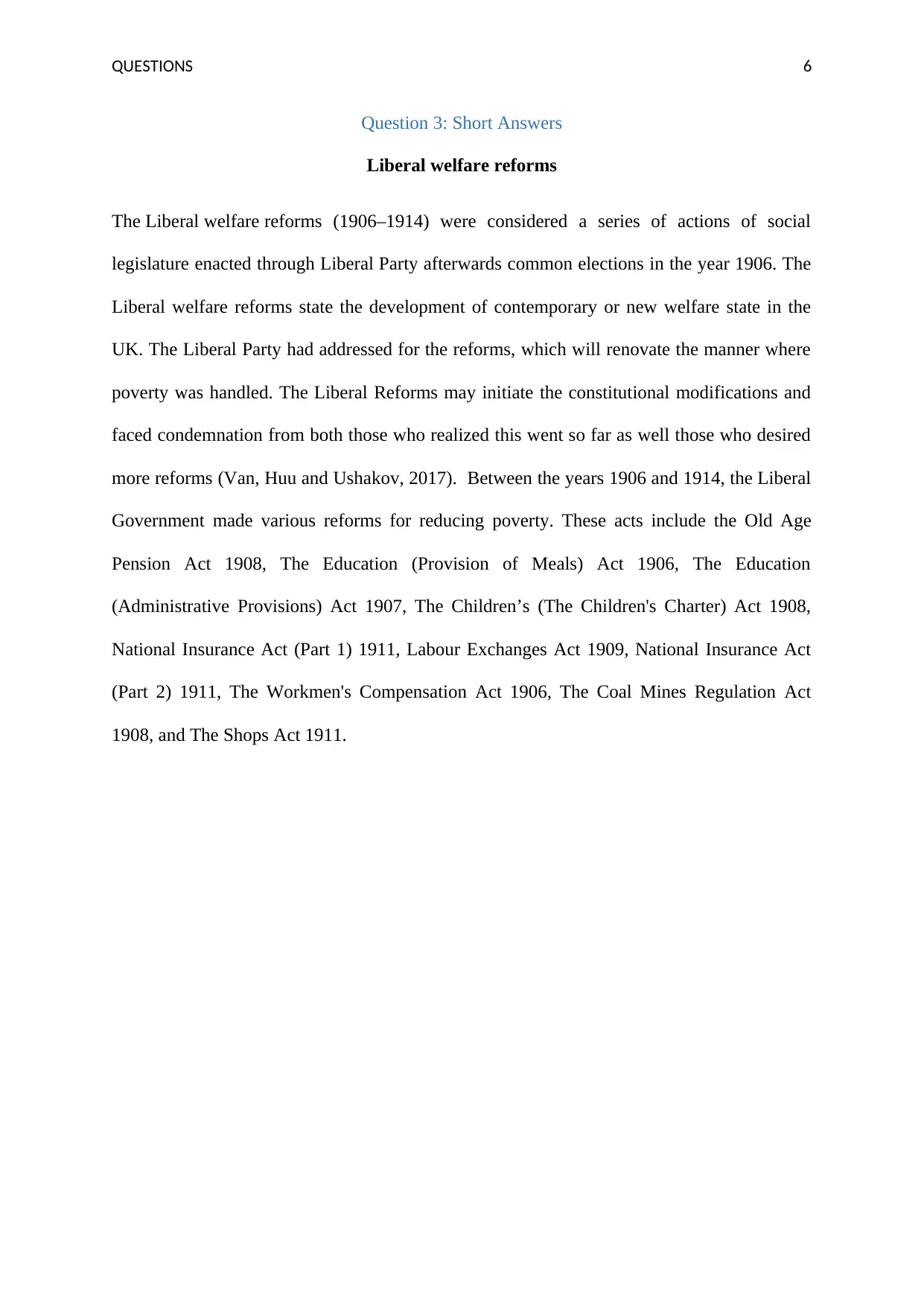
QUESTIONS 6
Question 3: Short Answers
Liberal welfare reforms
The Liberal welfare reforms (1906–1914) were considered a series of actions of social
legislature enacted through Liberal Party afterwards common elections in the year 1906. The
Liberal welfare reforms state the development of contemporary or new welfare state in the
UK. The Liberal Party had addressed for the reforms, which will renovate the manner where
poverty was handled. The Liberal Reforms may initiate the constitutional modifications and
faced condemnation from both those who realized this went so far as well those who desired
more reforms (Van, Huu and Ushakov, 2017). Between the years 1906 and 1914, the Liberal
Government made various reforms for reducing poverty. These acts include the Old Age
Pension Act 1908, The Education (Provision of Meals) Act 1906, The Education
(Administrative Provisions) Act 1907, The Children’s (The Children's Charter) Act 1908,
National Insurance Act (Part 1) 1911, Labour Exchanges Act 1909, National Insurance Act
(Part 2) 1911, The Workmen's Compensation Act 1906, The Coal Mines Regulation Act
1908, and The Shops Act 1911.
Question 3: Short Answers
Liberal welfare reforms
The Liberal welfare reforms (1906–1914) were considered a series of actions of social
legislature enacted through Liberal Party afterwards common elections in the year 1906. The
Liberal welfare reforms state the development of contemporary or new welfare state in the
UK. The Liberal Party had addressed for the reforms, which will renovate the manner where
poverty was handled. The Liberal Reforms may initiate the constitutional modifications and
faced condemnation from both those who realized this went so far as well those who desired
more reforms (Van, Huu and Ushakov, 2017). Between the years 1906 and 1914, the Liberal
Government made various reforms for reducing poverty. These acts include the Old Age
Pension Act 1908, The Education (Provision of Meals) Act 1906, The Education
(Administrative Provisions) Act 1907, The Children’s (The Children's Charter) Act 1908,
National Insurance Act (Part 1) 1911, Labour Exchanges Act 1909, National Insurance Act
(Part 2) 1911, The Workmen's Compensation Act 1906, The Coal Mines Regulation Act
1908, and The Shops Act 1911.
Paraphrase This Document
Need a fresh take? Get an instant paraphrase of this document with our AI Paraphraser
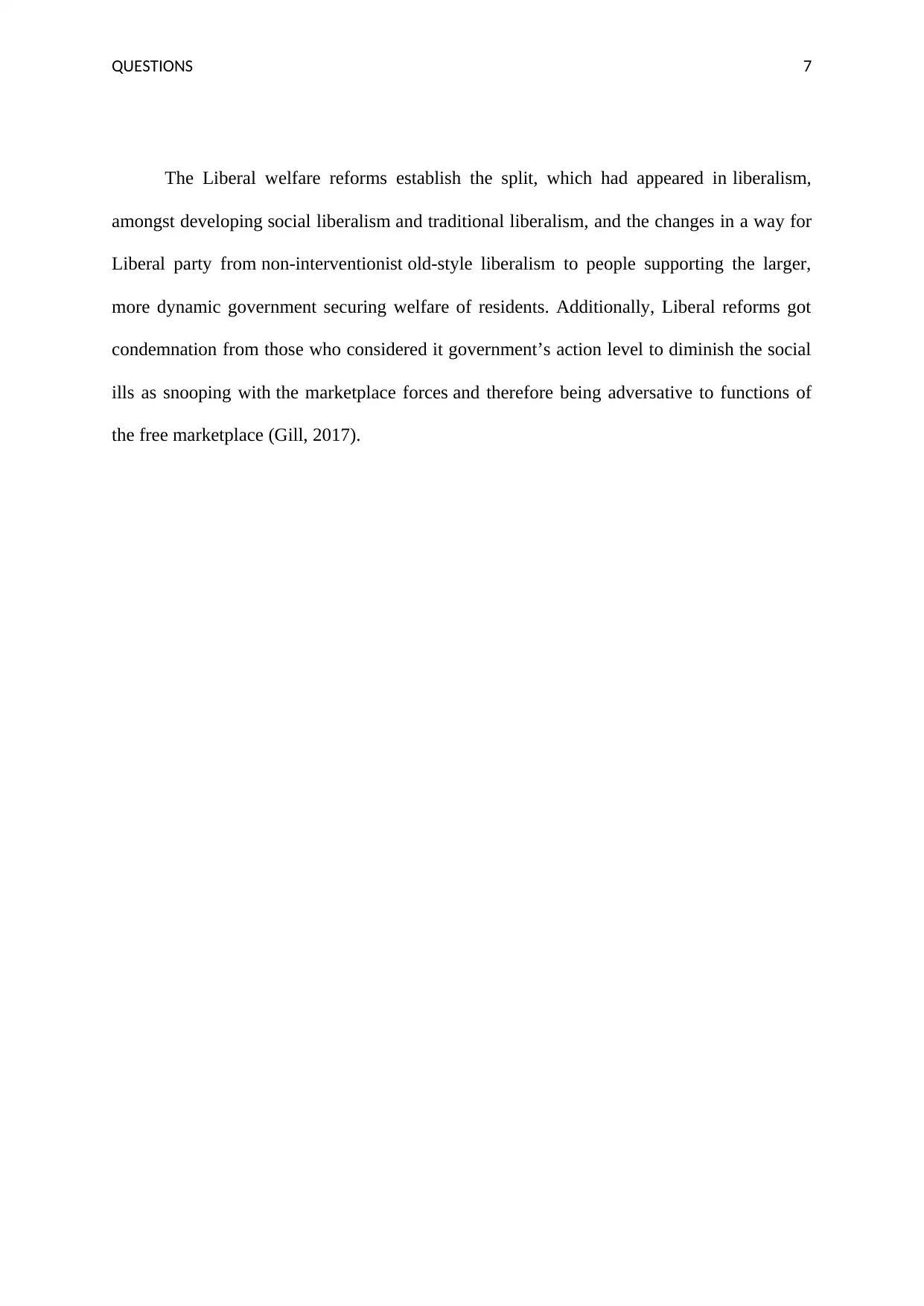
QUESTIONS 7
The Liberal welfare reforms establish the split, which had appeared in liberalism,
amongst developing social liberalism and traditional liberalism, and the changes in a way for
Liberal party from non-interventionist old-style liberalism to people supporting the larger,
more dynamic government securing welfare of residents. Additionally, Liberal reforms got
condemnation from those who considered it government’s action level to diminish the social
ills as snooping with the marketplace forces and therefore being adversative to functions of
the free marketplace (Gill, 2017).
The Liberal welfare reforms establish the split, which had appeared in liberalism,
amongst developing social liberalism and traditional liberalism, and the changes in a way for
Liberal party from non-interventionist old-style liberalism to people supporting the larger,
more dynamic government securing welfare of residents. Additionally, Liberal reforms got
condemnation from those who considered it government’s action level to diminish the social
ills as snooping with the marketplace forces and therefore being adversative to functions of
the free marketplace (Gill, 2017).
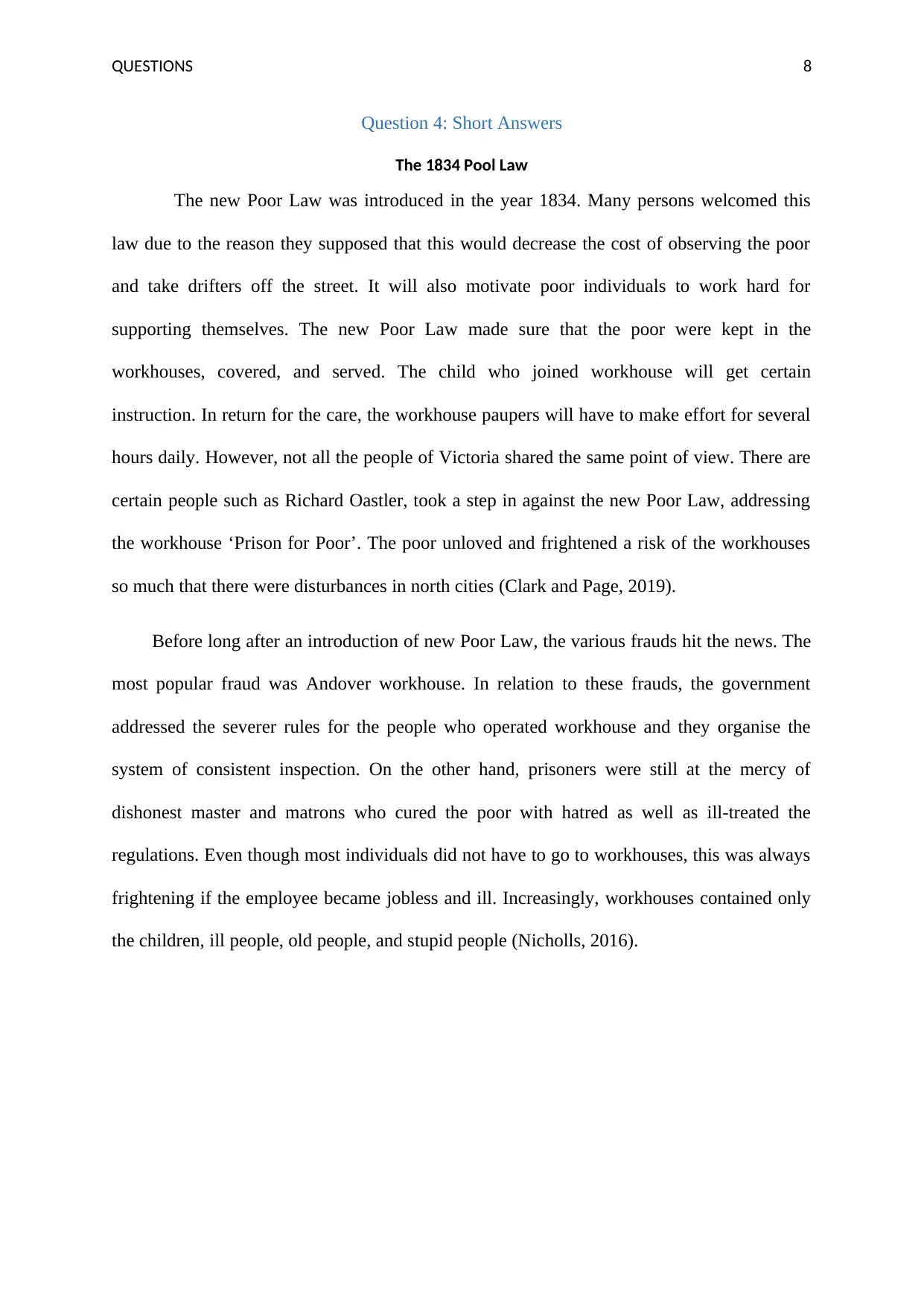
QUESTIONS 8
Question 4: Short Answers
The 1834 Pool Law
The new Poor Law was introduced in the year 1834. Many persons welcomed this
law due to the reason they supposed that this would decrease the cost of observing the poor
and take drifters off the street. It will also motivate poor individuals to work hard for
supporting themselves. The new Poor Law made sure that the poor were kept in the
workhouses, covered, and served. The child who joined workhouse will get certain
instruction. In return for the care, the workhouse paupers will have to make effort for several
hours daily. However, not all the people of Victoria shared the same point of view. There are
certain people such as Richard Oastler, took a step in against the new Poor Law, addressing
the workhouse ‘Prison for Poor’. The poor unloved and frightened a risk of the workhouses
so much that there were disturbances in north cities (Clark and Page, 2019).
Before long after an introduction of new Poor Law, the various frauds hit the news. The
most popular fraud was Andover workhouse. In relation to these frauds, the government
addressed the severer rules for the people who operated workhouse and they organise the
system of consistent inspection. On the other hand, prisoners were still at the mercy of
dishonest master and matrons who cured the poor with hatred as well as ill-treated the
regulations. Even though most individuals did not have to go to workhouses, this was always
frightening if the employee became jobless and ill. Increasingly, workhouses contained only
the children, ill people, old people, and stupid people (Nicholls, 2016).
Question 4: Short Answers
The 1834 Pool Law
The new Poor Law was introduced in the year 1834. Many persons welcomed this
law due to the reason they supposed that this would decrease the cost of observing the poor
and take drifters off the street. It will also motivate poor individuals to work hard for
supporting themselves. The new Poor Law made sure that the poor were kept in the
workhouses, covered, and served. The child who joined workhouse will get certain
instruction. In return for the care, the workhouse paupers will have to make effort for several
hours daily. However, not all the people of Victoria shared the same point of view. There are
certain people such as Richard Oastler, took a step in against the new Poor Law, addressing
the workhouse ‘Prison for Poor’. The poor unloved and frightened a risk of the workhouses
so much that there were disturbances in north cities (Clark and Page, 2019).
Before long after an introduction of new Poor Law, the various frauds hit the news. The
most popular fraud was Andover workhouse. In relation to these frauds, the government
addressed the severer rules for the people who operated workhouse and they organise the
system of consistent inspection. On the other hand, prisoners were still at the mercy of
dishonest master and matrons who cured the poor with hatred as well as ill-treated the
regulations. Even though most individuals did not have to go to workhouses, this was always
frightening if the employee became jobless and ill. Increasingly, workhouses contained only
the children, ill people, old people, and stupid people (Nicholls, 2016).
1 out of 9
Related Documents
Your All-in-One AI-Powered Toolkit for Academic Success.
+13062052269
info@desklib.com
Available 24*7 on WhatsApp / Email
![[object Object]](/_next/static/media/star-bottom.7253800d.svg)
Unlock your academic potential
© 2024 | Zucol Services PVT LTD | All rights reserved.





